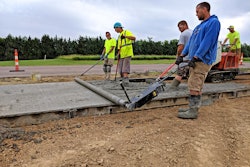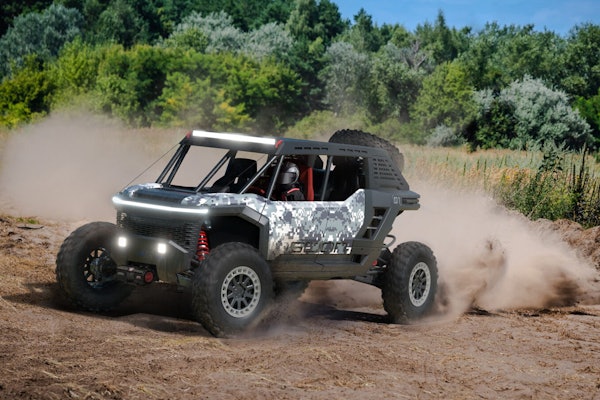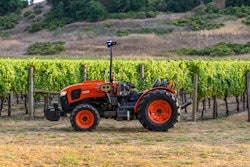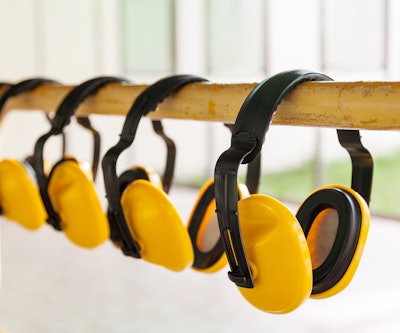
For crews consistently working with loud equipment throughout the day, hearing loss is a realistic concern, which is why it’s important to stress proper hearing protection to crew members.
When determining when hearing protection is and isn’t necessary for a task, Mark Chisholm, certified Stihl arborist with his family-owned company Aspen Tree Expert Company in Jackson, New Jersey, says he looks at two factors: the manufacturer’s recommendations and at what point the sounds become uncomfortable to the user’s ears.
“Depending on how long you’re going to be around the equipment, it might make more sense to use hearing protection just to be on the safe side,” says Chisholm. “Whenever we talk about anything in the industry, we always are wondering how it affects safety, so that’s our first focus. And I think it’s the tone in a lot of other industries now, too. For tree care, in particular, we’re really focused on safety.”
Crew members can choose to wear earplugs or earmuffs, as each person will be comfortable with something different, and Chisholm says some pieces of hearing protection will have a rating system built in. Regardless of which option is chosen, it’s vital that that piece of personal protective equipment (PPE) has the right rating for whatever job will be performed.
“For us, there’s no allowance of not wearing the proper PPE at any given time,” he says. “We don’t allow someone to make one cut with a chainsaw without having the right gear on. If you have to make one cut, you either use a hand saw or you go put all of your PPE on and then make the cut.”
Since each task will require a different level of protection, Chisholm says you can always take the tailored approach to choose which PPE fits your crews.
But when in doubt, Chisholm recommends getting the highest grade of protection and using it for every job on the roster instead of constantly switching from a lower to higher protection level.
“For example, if you’re standing next to a wood chipper all day, you may need a higher rating than if you’re running some type of outdoor handheld power equipment like a chainsaw,” says Chisholm.
Jobsite hazards
When considering the hazards associated with loud equipment, hearing loss is at the top of the list, but take a second to consider what other issues could be lurking.
For instance, Chisholm says not many people consider the fact that long term exposure to loud noises can lead to daily fatigue.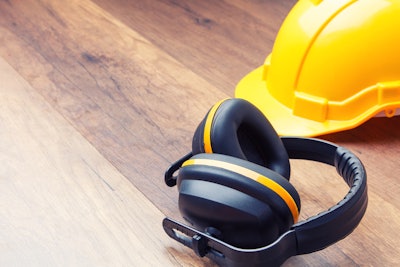
In his experience, Chisholm says people don’t always consider fatigue a serious issue, but when that feeling carries over into daily work with dangerous equipment, the results can be disastrous. When workers are fatigued, Chisholm says there’s a higher chance that they will lose focus while working, which directly impacts decision-making abilities.
“Usually, the loud noise is the first thing people notice, and there are studies that show that hearing protection will actually, over time, reduce fatigue on the jobsite,” says Chisholm. “So, if for no other reason, we stress it to help people stay sharp and focused and not get fatigued too soon.”
The inability to communicate with teammates while working in loud environments is also a challenge many in the industry face. When this is the case, Chisholm says it’s imperative that your crews have some alternative method to communicate, such as generic hand signals or even learning sign language. Chisholm also recommends always having a spotter on hand to help keep watch.
One handy tool Chisholm says his crews have taken advantage of is communication headsets that are built into the hearing protection. For those who opt, instead, to use earplugs, Chisholm says the headsets fit seamlessly over the earplugs and still allow crew members to hear what’s being said.
Chisholm says they utilize these headsets whenever they are performing high-risk jobs where it’s imperative that they can stay in contact with each other throughout the process.
“For example, we could use them if we were doing a large removal with a crane,” says Chisholm. “A crane is noisy, there’s a lot of equipment running and in this setting, a tree climber could be 100 feet or more away from a crane operator. Yet, because we actually communicate just like we’re standing right next to each other, it’s a much safer and more comfortable setting.”
Keeping crews accountable
Regardless of the fact it’s a requirement, Chisholm says you will still run into crew members who actively oppose wearing hearing protection for one reason or another.
In his experience, Chisholm says people will find an excuse to justify not wearing hearing protection, and he believes it directly correlates with people not liking being told what to do.
“In this industry, people have this ego they have to deal with as well because they are trying to be ‘tough’ and show that they can do this difficult job that maybe has some danger involved,” says Chisholm. “Once you start to deal with that aspect, you get more people to comply.”
Even today, Chisholm says this mentality keeps some tree care workers from wearing hard hats on the job, and he cautions companies against letting this type of behavior continue, especially with social media being so prevalent.
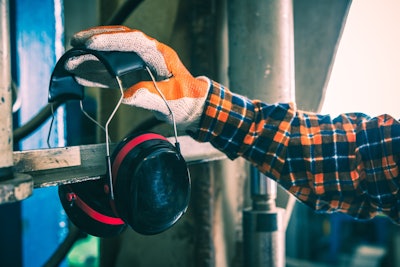
“OSHA will now give penalties directly to the person in violation, whereas it used to go to the company,” says Chisholm. “Now, the person will be directly fined and have to pay the fee. Last time I checked, the fee for a helmet violation was close to $750 per incident.”
On the plus side, Chisholm says having this possibility of publicly being called out for not following safety guidelines does add in an accountability element that hasn’t always been present. Personally, Chisholm believes the accountability aspect is huge, especially in the tree care business.
“As a business owner, you can’t have people going around not protecting themselves properly,” he says. “The liability is there, the insurance issues are there, it gets very costly and there’s just no room for it in this day and age.”
To drive home the importance of using hearing protection and other PPE, Chisholm says it has to come from the top and flow down to the rest of the employees. If those in charge aren’t following the rules, Chisholm says you can’t expect the rest of the company to follow.
Taking care of employees
It’s recommended by the American National Standards Institute (ANSI) that a base level hearing check be performed annually to ensure workers aren’t negatively affected by loud equipment, and Chisholm says even though it isn’t required, offering your crew members a free hearing test each year is a good idea.
Chisholm points out that even if your crews are wearing hearing protection that’s properly rated for whatever noise level they’re exposed to, there’s always a chance they could be using the PPE improperly. Since hearing loss sets in gradually in most cases, it could be a long time before crew members start exhibiting any signs, which makes annual hearing tests even more valuable.
To help prevent improper usage, make sure you walk through how to properly wear and adjust the hearing protection, and try testing its noise reduction quality before hitting the jobsite.




